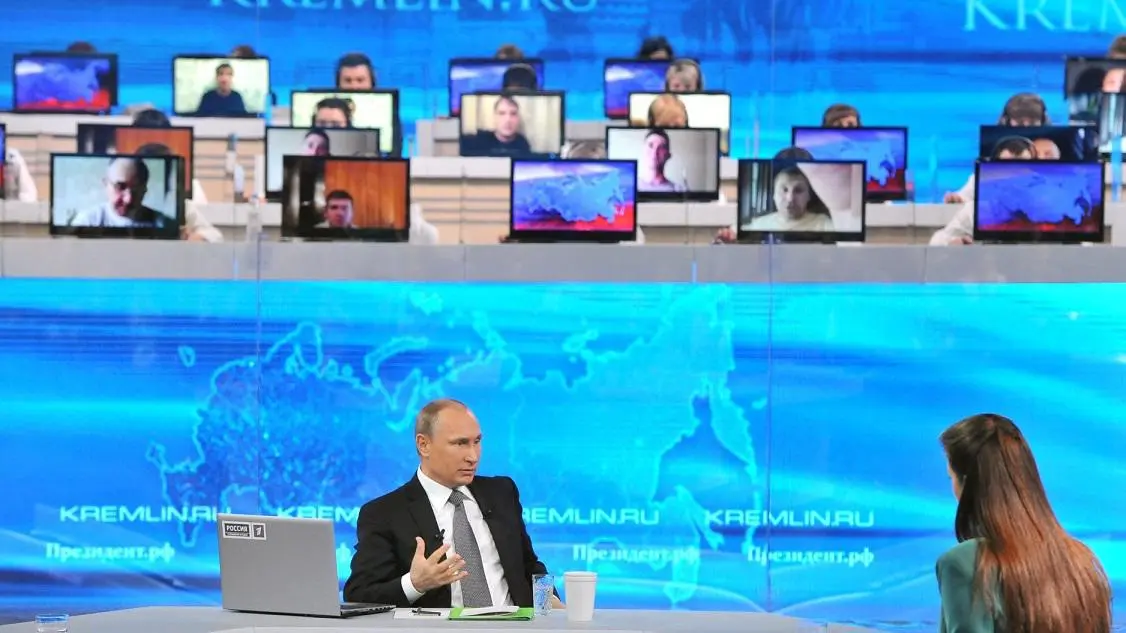Russia's state of the art media strategy

As Russia has pursued an increasingly aggressive foreign policy in recent years, a new study argues that media monitoring can shed light on the Kremlin’s opaque decision-making and help explain Russian president Vladimir Putin’s tight grip on power, despite his domestic economic woes.
Russia's challenges have mounted in recent years. The country’s economy declined by an estimated 4.7 per cent during 2015 and 2016, while increasing numbers of its population are living in poverty. Internationally, alleged interference in eastern Ukraine, the annexation of Crimea, and most recently, interventions in the Syrian civil war have turned Russia into a pariah state.
Kremlin watchers debate whether these economic shocks or isolation abroad will lead to domestic unrest and further acts of international aggression. But Dr Tomila Lankina, Associate Professor of International Relations at LSE, finds this approach overlooks Russia’s deft and sophisticated media management, which has been instrumental in managing internal dissent and offers clues to Putin’s next international move.
Dr Lankina’s study focused on several pivotal moments of public dissent in Russia’s recent history. In December 2011 and early 2012, thousands of citizens protested against allegations of electoral fraud and the announcement that Putin would again stand for the Russian presidency.
Dr Lankina said: "When there were protests around Putin’s re-election, there was a rapid mobilisation of Russia’s state-controlled media to present narratives of the protests using the language of chaos, violence and disorder. But when nationalist protests centred on issues of economic migration erupted in Moscow in October 2013, the media did not stigmatise the protesters and rioters in this negative way."
Similar media analysis was then applied to explore how Russia’s state-controlled media covered the Euromaidan protests and the Revolution of Dignity, a wave of demonstrations and civil unrest in Ukraine that began in late 2013 around country’s relationship with the European Union and Russia.
The analysis revealed that Russia’s state-controlled media presented the protests as the work of "fascists" and ultra-nationalists who posed a threat to ethnic Russians, in contrast with Ukrainian and Russian media outlets outside of the Kremlin’s control. This trend reached its apex around February 2014, when the Russia-supported Ukrainian president Viktor Yanukovych fled the country.
But when, following annexation of Crimea in 2014, domestic sentiment and public opinion among ethnic Russians in Ukraine’s eastern territories did not show high levels of support for the separation of Ukraine’s territories in the Donbas, the Russian media responded quickly. The media toned down the aggressively negative narratives about the Euromaidan protests, and how a pro-EU orientation Ukraine would threaten ethnic Russians.
These responses represent the Russian regime’s pursuit of subtle techniques of media manipulation, where the protests were presented either using the vocabulary of "disorder"; or the "freedom to protest" frame, depending on the overall public mood.
Dr Lankina said: "The media analysis techniques developed as part of the research project allowed us to perform electronic content analysis of media framing, so we can discern the nuances of media coverage of protest."
"Narratives were delivered in terms of chaos and disorder, with all the negative semantic baggage that comes with such vocabulary, or as citizen’s right to protest, which is considered a good thing in a democracy."
By deftly using these different frames, Russian media have altered the coverage of public discontent at home and abroad in ways meant to undermine dissent or, when necessary, to cater to public sentiment.
Studying the framing methods used by the Kremlin show that media analysis could be a useful tool for exploring shifts in Russia’s domestic and foreign policy. Dr Lankina said: "This analysis helps shed light on policymaking in Russia, at a time when decision-making is becoming more opaque."
For Dr Lankina, Russia’s media management represents evolution from the former Soviet system, where the government relied almost exclusively on censorship. She said: "In the modern era we know that the old methods are not going to work due to media diversification, particularly through social media."
However, Dr Lankina identifies a number of enduring parallels between the current Russian government and the old Soviet regime, such as mixing facts with faction, and planting misinformation into the public domain which is reproduced by more credible media outlets.
Domestically, this media strategy is helping manage discontent to divert public anger away from the Kremlin as Russia’s economic woes have deepened. "The state controlled media is very savvy at deflecting responsibility to lower levels of government when there is government failure. They often successfully blame the local mayor, local developers, or regional governments."
Dr Lankina feels that this tactical media strategy has proved to be an important asset to the Putin regime, and helps explain why he is a rare example of a leader who has thrived during an economic downturn. "Currently, it is hard to imagine that dissent at its present levels would lead to regime change. This is more likely to come from intra-elite power struggles rather than a grassroots movement; many people who are hopeful for Russia’s future see this as the most likely path to democracy."